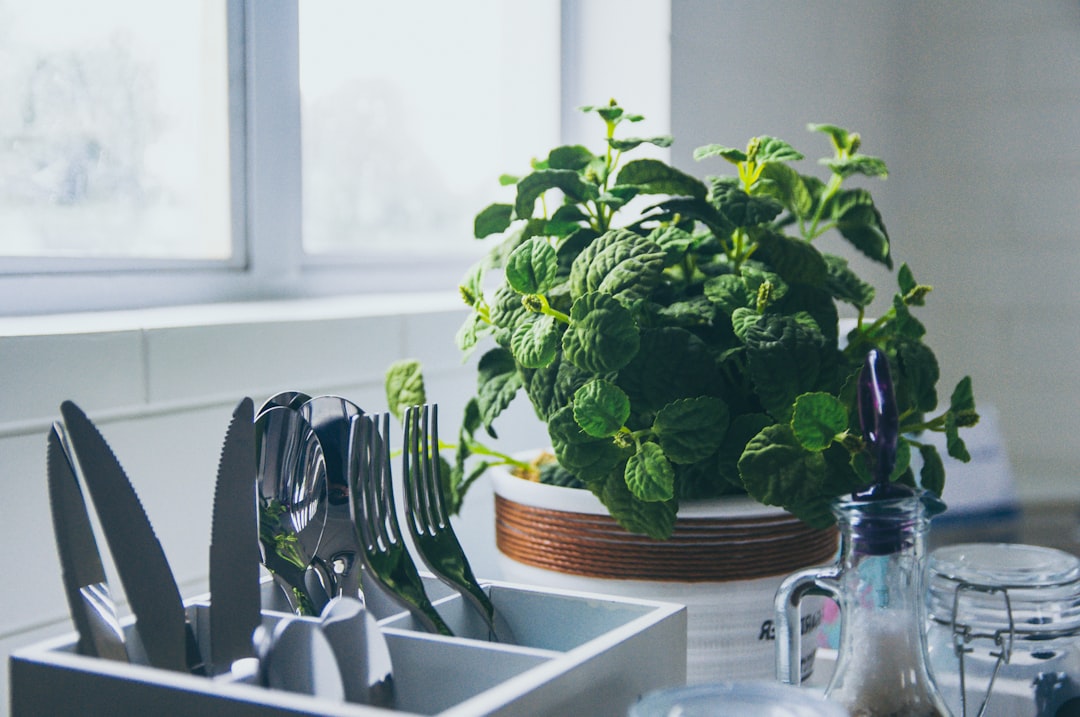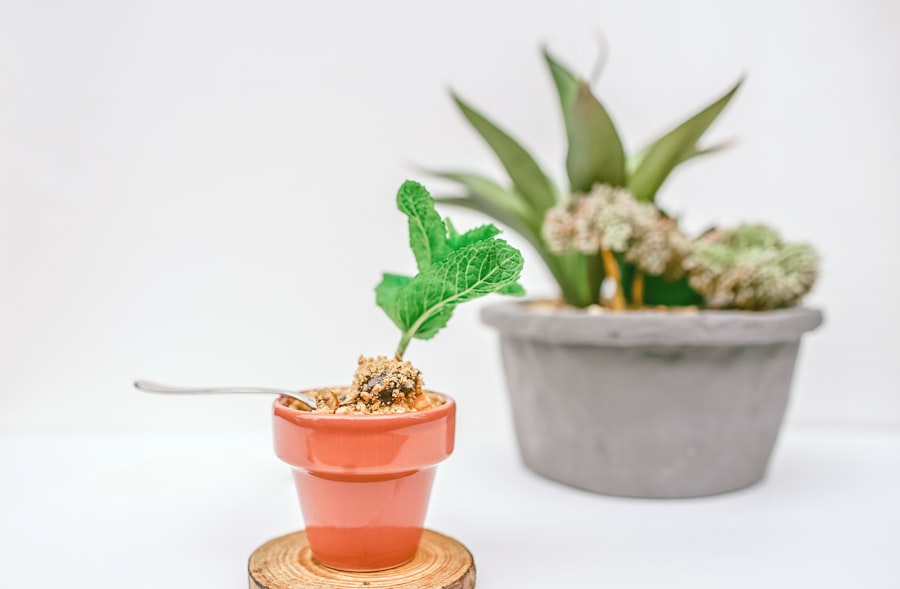Growing Mint: Tips for a Thriving Herb Garden

Mint is a versatile herb that has been used in cooking and gardening for centuries. Its refreshing flavor and aroma make it a popular choice for a variety of dishes and beverages. Mint is also known for its ability to attract beneficial insects and repel pests, making it a valuable addition to any garden. However, in order to successfully grow mint, it is important to choose the right variety and understand its growing conditions.
Choosing the Right Mint Variety for Your Garden
There are many different varieties of mint to choose from, each with its own unique characteristics. Some popular varieties include spearmint, peppermint, chocolate mint, and pineapple mint. Spearmint is the most commonly used variety and is known for its mild flavor. Peppermint has a stronger, more menthol flavor and is often used in teas and desserts. Chocolate mint has a hint of chocolate flavor, while pineapple mint has a fruity aroma.
When choosing a mint variety for your garden, there are several factors to consider. First, think about how you plan to use the mint. If you primarily want to use it in cooking, spearmint or peppermint may be the best choice. If you want to use it in cocktails or desserts, you may prefer a variety with a more unique flavor, such as chocolate mint or pineapple mint.
Another factor to consider is the growing conditions in your garden. Some varieties of mint are more tolerant of heat and drought, while others prefer cooler temperatures and moist soil. Consider the climate in your area and choose a variety that will thrive in those conditions.
Understanding the Growing Conditions that Mint Needs
Mint is a relatively easy herb to grow, but it does have specific growing conditions that need to be met in order for it to thrive. Mint prefers full sun but can tolerate some shade. It also prefers well-draining soil with a pH between 6.0 and 7.0. If your soil is too acidic, you can add lime to raise the pH. If it is too alkaline, you can add sulfur to lower the pH.
One common issue that arises when growing mint is root rot, which is caused by overwatering and poor drainage. To prevent root rot, make sure your soil has good drainage and only water your mint when the top inch of soil is dry. Mint also prefers cooler temperatures and can struggle in hot, humid climates. If you live in a hot climate, consider planting mint in a partially shaded area or providing some shade during the hottest part of the day.
Preparing the Soil for Mint Planting
| Soil Preparation Metric | Measurement |
|---|---|
| Soil pH | 6.0-7.0 |
| Soil Type | Loamy |
| Soil Temperature | 60-70°F |
| Organic Matter Content | 2-3% |
| Nutrient Content | High in nitrogen and potassium |
| Soil Moisture | Moist, but not waterlogged |
Before planting mint, it is important to prepare the soil to ensure optimal growing conditions. Start by testing the pH of your soil using a soil testing kit. If the pH is too high or too low, you can adjust it by adding lime or sulfur, as mentioned earlier.
Next, amend the soil with organic matter such as compost or well-rotted manure. This will help improve the soil structure and fertility, as well as provide essential nutrients for the mint plants. Spread a layer of organic matter over the planting area and mix it into the top few inches of soil using a garden fork or tiller.
In addition to amending the soil, it is important to ensure proper drainage and moisture retention. Mint prefers moist but not waterlogged soil. If your soil has poor drainage, consider adding organic matter or perlite to improve it. If your soil tends to dry out quickly, consider adding mulch around the mint plants to help retain moisture.
Planting Mint: Tips for Getting it Right
When planting mint, it is important to give each plant enough space to grow and spread. Mint plants can quickly take over an area if not properly contained. To prevent this, space your mint plants at least 18 inches apart. If you are planting mint in containers, choose a container that is at least 12 inches in diameter to allow for proper root growth.
When planting mint, dig a hole that is slightly larger than the root ball of the plant. Place the plant in the hole and backfill with soil, gently firming it around the roots. Water the plant thoroughly after planting to help settle the soil and remove any air pockets.
If you are planting mint in containers, make sure the container has drainage holes to prevent waterlogged soil. Fill the container with a well-draining potting mix and plant the mint as you would in the ground. Place the container in a sunny location and water regularly to keep the soil moist but not waterlogged.
Watering Mint: How Much is Too Much?

Proper watering is essential for the health and growth of mint plants. Mint prefers moist soil but can be prone to root rot if overwatered. As a general rule, water your mint plants when the top inch of soil is dry. This will help prevent overwatering and ensure that the roots have access to oxygen.
When watering mint, it is important to water deeply and thoroughly. This will encourage deep root growth and help the plants withstand periods of drought. Avoid shallow watering, as this can lead to shallow root growth and make the plants more susceptible to stress.
Signs of overwatering in mint include yellowing leaves, wilting, and a foul odor coming from the soil. If you notice these signs, reduce your watering frequency and make sure the soil has good drainage. Signs of underwatering include wilting, dry soil, and slow growth. If you notice these signs, increase your watering frequency and make sure the soil is evenly moist.
Fertilizing Mint: What to Use and When to Apply
Mint is a relatively low-maintenance herb that does not require heavy fertilization. However, it does benefit from regular feeding to ensure healthy growth and productivity. Mint requires nitrogen, phosphorus, and potassium, as well as trace elements such as iron, manganese, and zinc.
To provide these nutrients, you can use a balanced fertilizer with an NPK ratio of 10-10-10 or 14-14-14. Apply the fertilizer according to the package instructions, usually every 4-6 weeks during the growing season. Avoid overfertilizing mint, as this can lead to excessive leaf growth and a weaker flavor.
In addition to regular fertilization, you can also use organic matter such as compost or well-rotted manure to provide nutrients to the mint plants. Spread a layer of organic matter around the base of the plants and gently work it into the soil using a garden fork or tiller.
Pruning Mint: How to Keep it Under Control
Pruning is an important part of growing mint, as it helps prevent the plants from becoming invasive and encourages bushier growth. Mint plants have a tendency to spread quickly and can take over an area if not properly pruned.
To prune mint, start by removing any dead or damaged leaves and stems. This will help improve air circulation and prevent the spread of diseases. Next, trim back any long or leggy stems to encourage bushier growth. You can also pinch back the tips of the stems to promote branching.
Pruning mint should be done regularly throughout the growing season to keep the plants under control. It is best to prune mint in the morning when the plants are hydrated and less likely to wilt. Avoid pruning mint in the late afternoon or evening, as this can increase the risk of disease.
Dealing with Common Pests and Diseases in Mint
Mint is generally a hardy plant that is resistant to most pests and diseases. However, there are a few common issues that can affect mint plants. One of the most common pests is the mint aphid, which can cause stunted growth and yellowing leaves. To control aphids, you can spray the plants with a mixture of water and dish soap or use an organic insecticidal soap.
Another common pest is the mint flea beetle, which causes small holes in the leaves. To control flea beetles, you can use row covers or apply an organic insecticide labeled for flea beetles.
Mint is also susceptible to fungal diseases such as powdery mildew and rust. Powdery mildew appears as a white powdery coating on the leaves, while rust appears as orange or brown spots. To prevent these diseases, make sure your mint plants have good air circulation and avoid overhead watering. If you notice signs of fungal disease, remove and destroy affected leaves and treat the plants with a fungicide labeled for powdery mildew or rust.
Harvesting Mint: When and How to Do It
Mint can be harvested throughout the growing season, starting when the plants are about 6 inches tall. To harvest mint, simply snip off the leaves or stems that you need using a pair of clean scissors or pruning shears. It is best to harvest mint in the morning when the oils are most concentrated.
When harvesting mint, be sure to leave at least one-third of the plant intact to allow for regrowth. This will ensure a continuous supply of fresh mint throughout the season. If you need a large amount of mint at once, you can cut the entire plant back to about 2 inches above the ground. The plant will quickly regrow and provide a fresh supply of leaves.
Storing and Using Fresh Mint in Your Cooking
Fresh mint can be used in a variety of dishes and beverages, adding a refreshing flavor and aroma. It pairs well with fruits, vegetables, meats, and dairy products. Mint can be used in salads, sauces, marinades, desserts, and cocktails.
To store fresh mint, place the stems in a glass of water and cover the leaves with a plastic bag. Store the mint in the refrigerator and change the water every few days to keep it fresh. Alternatively, you can wrap the mint in a damp paper towel and place it in a plastic bag in the refrigerator.
To use fresh mint in your cooking, simply remove the leaves from the stems and chop or tear them as desired. Mint leaves can be added to salads, soups, stews, stir-fries, and sauces. They can also be used to make infused oils, vinegars, syrups, and teas.
Growing mint in your own garden can be a rewarding experience. By choosing the right mint variety and understanding its growing conditions, you can ensure that your mint plants thrive and provide you with a continuous supply of fresh mint throughout the season. Whether you use it in cooking or gardening, mint is a versatile herb that adds flavor and fragrance to any dish or garden. So why not start growing mint in your own garden today?



